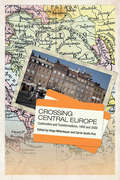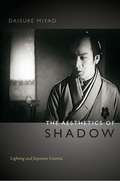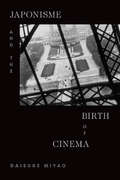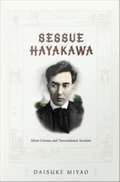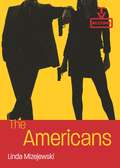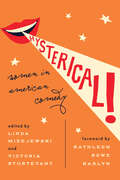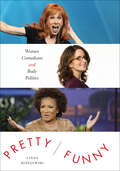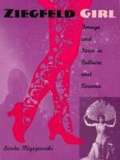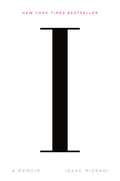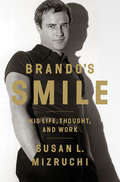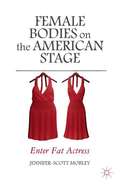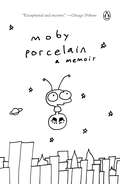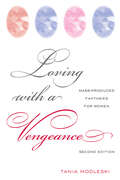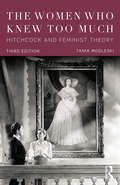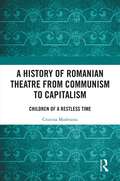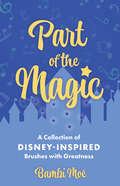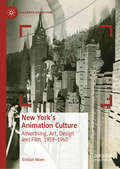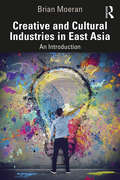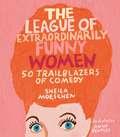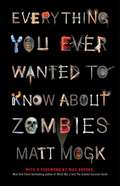- Table View
- List View
Crossing Central Europe: Continuities and Transformations, 1900-2000
by Helga Mitterbauer Carrie Smith-PreiCrossing Central Europe is a pioneering volume that focuses on the complex networks of transcultural interrelations in Central Europe from 1900 to 2000. Scholars from Canada, the United States, and Europe identify the motifs, topics, and ways of artistic creation that define this cross-cultural region. This interdisciplinary volume is divided into two historical periods and includes analyses of literature, film, music, architecture, and media. By focusing first on the interrelations in the nineteenth and early twentieth-century, the contributors reveal a complex trans-ethnic network at play that disseminated aesthetic ideals. This network continued to be a force of aesthetic influence leading into the twenty-first century despite globalization and the influence of mass media. Helga Mitterbauer and Carrie Smith-Prei have embarked on a study of the overlapping artistic influences that have outlasted both the National Socialist regime and the Cold War.
The Aesthetics of Shadow: Lighting and Japanese Cinema
by Daisuke MiyaoIn this revealing study, Daisuke Miyao explores "the aesthetics of shadow" in Japanese cinema in the first half of the twentieth century. This term, coined by the production designer Yoshino Nobutaka, refers to the perception that shadows add depth and mystery. Miyao analyzes how this notion became naturalized as the representation of beauty in Japanese films, situating Japanese cinema within transnational film history. He examines the significant roles lighting played in distinguishing the styles of Japanese film from American and European film and the ways that lighting facilitated the formulation of a coherent new Japanese cultural tradition. Miyao discusses the influences of Hollywood and German cinema alongside Japanese Kabuki theater lighting traditions and the emergence of neon commercial lighting during this period. He argues that lighting technology in cinema had been structured by the conflicts of modernity in Japan, including capitalist transitions in the film industry, the articulation of Japanese cultural and national identity, and increased subjectivity for individuals. By focusing on the understudied element of film lighting and treating cinematographers and lighting designers as essential collaborators in moviemaking, Miyao offers a rereading of Japanese film history.
Japonisme and the Birth of Cinema
by Daisuke MiyaoIn Japonisme and the Birth of Cinema, Daisuke Miyao explores the influence of Japanese art on the development of early cinematic visual style, particularly the actualité films made by the Lumière brothers between 1895 and 1905. Examining nearly 1,500 Lumière films, Miyao contends that more than being documents of everyday life, they provided a medium for experimenting with aesthetic and cinematic styles imported from Japan. Miyao further analyzes the Lumière films produced in Japan as a negotiation between French Orientalism and Japanese aesthetics. The Lumière films, Miyao shows, are best understood within a media ecology of photography, painting, and cinema, all indebted to the compositional principles of Japonisme and the new ideas of kinetic realism it inspired. The Lumière brothers and their cinematographers shared the contemporaneous obsession among Impressionist and Post-Impressionist artists about how to instantly and physically capture the movements of living things in the world. Their engagement with Japonisme, he concludes, constituted a rich and productive two-way conversation between East and West.
Sessue Hayakawa: Silent Cinema and Transnational Stardom
by Daisuke MiyaoWhile the actor Sessue Hayakawa (1886-1973) is perhaps best known today for his Oscar-nominated turn as a Japanese military officer in The Bridge on the River Kwai (1957), in the early twentieth century he was an internationally renowned silent film star, as recognizable as Charlie Chaplin or Douglas Fairbanks. In this critical study of Hayakawa's stardom, Daisuke Miyao reconstructs the Japanese actor's remarkable career, from the films that preceded his meteoric rise to fame as the star of Cecil B. DeMille's The Cheat (1915) through his reign as a matinee idol and the subsequent decline and resurrection of his Hollywood fortunes. Drawing on early-twentieth-century sources in both English and Japanese, including Japanese-language newspapers in the United States, Miyao illuminates the construction and reception of Hayakawa's stardom as an ongoing process of cross-cultural negotiation. Hayakawa's early work included short films about Japan that were popular with American audiences as well as spy films that played upon anxieties about Japanese nationalism. The Jesse L. Lasky production company sought to shape Hayakawa's image by emphasizing the actor's Japanese traits while portraying him as safely assimilated into U. S. culture. Hayakawa himself struggled to maintain his sympathetic persona while creating more complex Japanese characters that would appeal to both American and Japanese audiences. The star's initial success with U. S. audiences created ambivalence in Japan, where some described him as traitorously Americanized and others as a positive icon of modernized Japan. This unique history of transnational silent-film stardom focuses attention on the ways that race, ethnicity, and nationality influenced the early development of the global film industry.
The Americans (TV Milestones Series)
by Linda MizejewskiBased on the actual KGB strategy of planting "illegals" into American life during the Cold War, The Americans (FX 2013–2018) focuses on Philip and Elizabeth Jennings (Matthew Rhys and Kerri Russell), Soviet spies posing as middlebrow travel agents in the Virginia suburbs. Groundbreaking and unsettling, The Americans spins its stories of espionage, violence, and politics around narratives of marriage, romance, bromance, and family. Exploring the series’ bold merger of the spy genre and domestic melodrama, author Linda Mizejewski focuses on the characters and relationships that made this series memorable: the extraordinary women who defy the femme fatale stereotype of the spy genre, the conflicted men, and perhaps most shockingly, the children who are both victims and provocateurs Do viewers of this Cold War thriller root for "the good guys"—the American agents in pursuit of the Jennings—or for the Jennings themselves, the attractive couple whose personal stories compel us even as they plot the takedown of the United States? Mizejewski argues for the importance of The Americans’ portrayal of 1980s suburban life as a microcosm of the moral complexities of citizenship and national identity. Drawing on television studies and feminist media theory, this book examines the series’ seamless loop of espionage violence and family melodrama, as well as its savvy uses of 1980s pop culture and music. Far from invoking nostalgia, the replication of the 1980s "look" invokes uncertainties about how, exactly, we should see Reagan’s America and the Cold War. Yet the appeal of this series rests on solid footing in the Americanism it both critiques and espouses. Mizejewski examines The Americans’ struggles with this ambiguity and with the contradictions of identity, gender, marriage, and the meanings of home. Everyone from scholars and students of television and media studies, genre studies, gender and sexuality studies, and popular culture, to superfans who can’t believe the show is over will revel in this highly approachable and fun read.
Hysterical!: Women in American Comedy
by Linda MizejewskiSusan Koppelman Award Winner: “A juicy read for those who love the many ways female comics use their art to question the patriarchy.” ?BustAmy Schumer, Samantha Bee, Mindy Kaling, Melissa McCarthy, Tig Notaro, Leslie Jones, and a host of hilarious peers are killing it nightly on American stages and screens, smashing the tired stereotype that women aren’t funny. But today’s funny women didn’t come out of nowhere. Fay Tincher’s daredevil stunts, Mae West’s linebacker walk, Lucille Ball’s manic slapstick, Carol Burnett’s athletic pratfalls, Ellen DeGeneres’s tomboy pranks, Whoopi Goldberg’s sly twinkle, and Tina Fey’s acerbic wit all paved the way for contemporary unruly women, whose comedy upends the norms and ideals of women’s bodies and behaviors.Hysterical! Women in American Comedy delivers a lively survey of women comics from the stars of the silent cinema up through the multimedia presences of Tina Fey and Lena Dunham. This anthology of original essays includes contributions by the field’s leading authorities, introducing a new framework for women’s comedy that analyzes the implications of hysterical laughter and hysterically funny performances. Expanding on previous studies of comedians such as Mae West, Moms Mabley, and Margaret Cho, and offering the first scholarly work on comedy pioneers Mabel Normand, Fay Tincher, and Carol Burnett, the contributors explore such topics as racial/ethnic/sexual identity, celebrity, stardom, censorship, auteurism, cuteness, and postfeminism across multiple media. Situated within the main currents of gender and queer studies, as well as American studies and feminist media scholarship, Hysterical! masterfully demonstrates that hysteria—women acting out and acting up—is a provocative, empowering model for women’s comedy.“An invaluable collection and a great read.” ?Journal of Popular CultureWinner of a Susan Koppelman Award for Best Anthology, Multi-Authored, or Edited Book in Feminist Studies, Popular and American Culture Associations (PACA), 2017
Hysterical!: Women in American Comedy
by Linda MizejewskiSusan Koppelman Award Winner: &“A juicy read for those who love the many ways female comics use their art to question the patriarchy.&” —Bust Amy Schumer, Samantha Bee, Mindy Kaling, Melissa McCarthy, Tig Notaro, Leslie Jones, and a host of hilarious peers are killing it nightly on American stages and screens, smashing the tired stereotype that women aren&’t funny. But today&’s funny women didn&’t come out of nowhere. Fay Tincher&’s daredevil stunts, Mae West&’s linebacker walk, Lucille Ball&’s manic slapstick, Carol Burnett&’s athletic pratfalls, Ellen DeGeneres&’s tomboy pranks, Whoopi Goldberg&’s sly twinkle, and Tina Fey&’s acerbic wit all paved the way for contemporary unruly women, whose comedy upends the norms and ideals of women&’s bodies and behaviors.Hysterical! Women in American Comedy delivers a lively survey of women comics from the stars of the silent cinema up through the multimedia presences of Tina Fey and Lena Dunham. This anthology of original essays includes contributions by the field&’s leading authorities, introducing a new framework for women&’s comedy that analyzes the implications of hysterical laughter and hysterically funny performances. Expanding on previous studies of comedians such as Mae West, Moms Mabley, and Margaret Cho, and offering the first scholarly work on comedy pioneers Mabel Normand, Fay Tincher, and Carol Burnett, the contributors explore such topics as racial/ethnic/sexual identity, celebrity, stardom, censorship, auteurism, cuteness, and postfeminism across multiple media. Situated within the main currents of gender and queer studies, as well as American studies and feminist media scholarship, Hysterical! masterfully demonstrates that hysteria—women acting out and acting up—is a provocative, empowering model for women&’s comedy. &“An invaluable collection and a great read.&” ?Journal of Popular CultureWinner of a Susan Koppelman Award for Best Anthology, Multi-Authored, or Edited Book in Feminist Studies, Popular and American Culture Associations (PACA), 2017
Pretty/Funny: Women Comedians and Body Politics
by Linda MizejewskiWomen in comedy have traditionally been pegged as either "pretty" or "funny. " Attractive actresses with good comic timing such as Katherine Hepburn, Lucille Ball, and Julia Roberts have always gotten plum roles as the heroines of romantic comedies and television sitcoms. But fewer women who write and perform their own comedy have become stars, and, most often, they've been successful because they were willing to be funny-looking, from Fanny Brice and Phyllis Diller to Lily Tomlin and Carol Burnett. In this pretty-versus-funny history, women writer-comedians--no matter what they look like--have ended up on the other side of "pretty," enabling them to make it the topic and butt of the joke, the ideal that is exposed as funny. Pretty/Funny focuses on Kathy Griffin, Tina Fey, Sarah Silverman, Margaret Cho, Wanda Sykes, and Ellen DeGeneres, the groundbreaking women comics who flout the pretty-versus-funny dynamic by targeting glamour, postfeminist girliness, the Hollywood A-list, and feminine whiteness with their wit and biting satire. Linda Mizejewski demonstrates that while these comics don't all identify as feminists or take politically correct positions, their work on gender, sexuality, and race has a political impact. The first major study of women and humor in twenty years, Pretty/Funny makes a convincing case that women's comedy has become a prime site for feminism to speak, talk back, and be contested in the twenty-first century.
Pretty/Funny: Women Comedians and Body Politics
by Linda Mizejewski“A totally engaging read [and] a fascinating look at the diversity and range of female comics . . . by an author who herself obviously has a sense of humor.” —Joanna E. Rapf, coeditor of The Blackwell Companion to Film ComedyWomen in comedy have traditionally been pegged as either “pretty” or “funny.” Attractive actresses with good comic timing such as Katherine Hepburn, Lucille Ball, and Julia Roberts have always gotten plum roles as the heroines of romantic comedies and television sitcoms. But fewer women who write and perform their own comedy have become stars—and often they’ve been successful because they were willing to be funny-looking, from Fanny Brice and Phyllis Diller to Lily Tomlin and Carol Burnett.Pretty/Funny focuses on Kathy Griffin, Tina Fey, Sarah Silverman, Margaret Cho, Wanda Sykes, and Ellen DeGeneres, the groundbreaking women comics who flout the pretty-versus-funny dynamic by targeting glamour, postfeminist girliness, the Hollywood A-list, and feminine whiteness with their wit and biting satire. Linda Mizejewski demonstrates that while these comics don’t all identify as feminists or take politically correct positions, their work on gender, sexuality, and race has a political impact. The first major study of women and humor in twenty years, Pretty/Funny makes a convincing case that women’s comedy has become a prime site for feminism to speak, talk back, and be contested in the twenty-first century.
Ziegfeld Girl: Image and Icon in Culture and Cinema
by Linda MizejewskiIn the first decades of the twentieth century, Broadway teemed with showgirls, but only the Ziegfeld Girl has survived in American popular culture--as a figure of legend, nostalgia, and camp. Featured in Florenz Ziegfeld Jr.'s renowned revues, which ran on Broadway from 1907 to 1931, the Ziegfeld Girl has appeared in her trademark feather headdresses, parading and posing, occasionally singing and dancing, in numerous musicals and musical films paying direct or indirect homage to the intrepid producer and his glorious Girl. Linda Mizejewski analyzes the Ziegfeld Girl as a cultural icon and argues that during a time when American national identity was in flux, Ziegfeld Girls were both products and representations of a white, upscale, heterosexual national ideal. Mizejewski traces the Ziegfeld Girl's connections to turn-of-the-century celebrity culture, black Broadway, the fashion industry, and the changing sexual and gender identities evident in mainstream entertainment during the Ziegfeld years. In addition, she emphasizes how crises of immigration and integration made the identity and whiteness of the American Girl an urgent issue on Broadway's revue stages during that era. Although her focus is on the showgirl as a "type," the analysis is intermingled with discussions of figures like Anna Held, Fanny Brice, and Bessie McCoy, the Yama Yama girl, as well as Ziegfeld himself. Finally, Mizejewski discusses the classic American films that have most vividly kept this showgirl alive in both popular and camp culture, including The Great Ziegfeld, Ziegfeld Girl, and the Busby Berkeley musicals that cloned Ziegfeld's showgirls for decades. Ziegfeld Girl will appeal to scholars and students in American studies, popular culture, theater and performance studies, film history, gender studies, gay and lesbian studies, and social history.
I. M.: A Memoir
by Isaac MizrahiIn I.M., Isaac Mizrahi offers a poignant, candid, and touching look back on his life so far. Growing up gay in a sheltered Syrian Jewish Orthodox family, Isaac had unique talents that ultimately drew him into fashion and later into celebrity circles that read like a who’s who of the twentieth and twenty-first centuries: Richard Avedon, Audrey Hepburn, Anna Wintour, Mikhail Baryshnikov, Meryl Streep, and Oprah Winfrey, to name only a few. <P><P> In his elegant memoir, Isaac delves into his lifelong battles with weight, insomnia, and depression. He tells what it was like to be an out gay man in a homophobic age and to witness the ravaging effects of the AIDS epidemic. Brimming with intimate details and inimitable wit, Isaac's narrative reveals not just the glamour of his years, but the grit beneath the glitz. Rich with memorable stories from in and out of the spotlight, I.M. illuminates deep emotional truths.
Brando's Smile: His Life, Thought, and Work
by Susan L. MizruchiA groundbreaking work that reveals how Marlon Brando shaped his legacy in art and life. When people think about Marlon Brando, they think of the movie star, the hunk, the scandals. In Brando's Smile, Susan L. Mizruchi reveals the Brando others have missed: the man who collected four thousand books; the man who rewrote scripts, trimming his lines to make them sharper; the man who consciously used his body and employed the objects around him to create believable characters; the man who loved Emily Dickinson's poetry. To write this biography, Mizruchi gained unprecedented access to a vast number of annotated books from Brando's library, hand-edited copies of screenplays, private letters, and recorded interviews that have never before been quoted in a biography. Original interviews with some of the still-living players from Brando's life, including Ellen Adler, his one-time girlfriend and the daughter of his acting teacher Stella Adler, provide even deeper insight into the complex person whose intelligence belied the high-school dropout. Mizruchi shows how Brando's embrace of foreign cultures and social outsiders led to his brilliant performances in unusual roles--a gay man, an Asian, a German soldier--to test himself and to foster empathy on a global scale. We also meet the political Brando: the civil rights activist, the close friend of James Baldwin, the actor who declined his Oscar to support Indian rights. More than seventy stunning--and many rare--photographs of Marlon Brando illuminate this portrait of the man who has left an astounding cultural legacy.
Female Bodies on the American
by Jennifer-Scott MobleyThe fat female body is a unique construction in American culture that has been understood in various ways during the twentieth and early twenty-first centuries. Analyzing post-WWII stage and screen performances, Mobley argues that the fat actress's body signals myriad cultural assumptions and suggests new ways of reading the body in performance.
Porcelain: A Memoir
by MobyFrom one of the most interesting and iconic musicians of our time, a piercingly tender, funny, and harrowing account of the path from suburban poverty and alienation to a life of beauty, squalor, and unlikely success out of the NYC club scene of the late '80s and '90s.There were many reasons Moby was never going to make it as a DJ and musician in the New York club scene. This was the New York of Palladium; of Mars, Limelight, and Twilo; of unchecked, drug-fueled hedonism in pumping clubs where dance music was still largely underground, popular chiefly among working-class African Americans and Latinos. And then there was Moby--not just a poor, skinny white kid from Connecticut, but a devout Christian, a vegan, and a teetotaler. He would learn what it was to be spat on, to live on almost nothing. But it was perhaps the last good time for an artist to live on nothing in New York City: the age of AIDS and crack but also of a defiantly festive cultural underworld. Not without drama, he found his way. But success was not uncomplicated; it led to wretched, if in hindsight sometimes hilarious, excess and proved all too fleeting. And so by the end of the decade, Moby contemplated an end in his career and elsewhere in his life, and put that emotion into what he assumed would be his swan song, his good-bye to all that, the album that would in fact be the beginning of an astonishing new phase: the multimillion-selling Play. At once bighearted and remorseless in its excavation of a lost world, Porcelain is both a chronicle of a city and a time and a deeply intimate exploration of finding one's place during the most gloriously anxious period in life, when you're on your own, betting on yourself, but have no idea how the story ends, and so you live with the honest dread that you're one false step from being thrown out on your face. Moby's voice resonates with honesty, wit, and, above all, an unshakable passion for his music that steered him through some very rough seas. Porcelain is about making it, losing it, loving it, and hating it. It's about finding your people, your place, thinking you've lost them both, and then, somehow, when you think it's over, from a place of well-earned despair, creating a masterpiece. As a portrait of the young artist, Porcelain is a masterpiece in its own right, fit for the short shelf of musicians' memoirs that capture not just a scene but an age, and something timeless about the human condition. Push play.
Porcelain: A Memoir
by MobyFrom one of the most interesting and iconic musicians of our time, a piercingly tender, funny, and harrowing account of the path from suburban poverty and alienation to a life of beauty, squalor, and unlikely success out of the NYC club scene of the late '80s and '90s.There were many reasons Moby was never going to make it as a DJ and musician in the New York club scene. This was the New York of Palladium; of Mars, Limelight, and Twilo; of unchecked, drug-fueled hedonism in pumping clubs where dance music was still largely underground, popular chiefly among working-class African Americans and Latinos. And then there was Moby--not just a poor, skinny white kid from Connecticut, but a devout Christian, a vegan, and a teetotaler. He would learn what it was to be spat on, to live on almost nothing. But it was perhaps the last good time for an artist to live on nothing in New York City: the age of AIDS and crack but also of a defiantly festive cultural underworld. Not without drama, he found his way. But success was not uncomplicated; it led to wretched, if in hindsight sometimes hilarious, excess and proved all too fleeting. And so by the end of the decade, Moby contemplated an end in his career and elsewhere in his life, and put that emotion into what he assumed would be his swan song, his good-bye to all that, the album that would in fact be the beginning of an astonishing new phase: the multimillion-selling Play. At once bighearted and remorseless in its excavation of a lost world, Porcelain is both a chronicle of a city and a time and a deeply intimate exploration of finding one's place during the most gloriously anxious period in life, when you're on your own, betting on yourself, but have no idea how the story ends, and so you live with the honest dread that you're one false step from being thrown out on your face. Moby's voice resonates with honesty, wit, and, above all, an unshakable passion for his music that steered him through some very rough seas. Porcelain is about making it, losing it, loving it, and hating it. It's about finding your people, your place, thinking you've lost them both, and then, somehow, when you think it's over, from a place of well-earned despair, creating a masterpiece. As a portrait of the young artist, Porcelain is a masterpiece in its own right, fit for the short shelf of musicians' memoirs that capture not just a scene but an age, and something timeless about the human condition. Push play.
Loving with a Vengeance: Mass Produced Fantasies for Women
by Tania ModleskiUpon its first publication, Loving with a Vengeance was a groundbreaking study of women readers and their relationship to mass-market romance fiction. Feminist scholar and cultural critic Tania Modleski has revisited her widely read book, bringing to this new edition a review of the issues that have, in the intervening years, shaped and reshaped questions of women's reading. With her trademark acuity and understanding of the power both of the mass-produced object, film, television, or popular literature, and the complex workings of reading and reception, she offers here a framework for thinking about one of popular culture's central issues.This edition includes a new introduction, a new chapter, and changes throughout the existing text.
The Women Who Knew Too Much: Hitchcock and Feminist Theory
by Tania ModleskiOriginally published in 1988, The Women Who Knew Too Much remains a classic work in film theory and feminist criticism. The book consists of a theoretical introduction and analyses of seven important films by Alfred Hitchcock, each of which provides a basis for an analysis of the female spectator as well as of the male spectator. Modleski considers the emotional and psychic investments of men and women in female characters whose stories often undermine the mastery of the cinematic "master of suspense." The third edition features an interview with the author by David Greven, in which he and Modleski reflect on how feminist and queer approaches to Hitchcock studies may be brought into dialogue. A teaching guide and discussion questions by Ned Schantz help instructors and students to delve into this seminal work of feminist film theory.
The Catholic Church and Antisemitism
by Ronald ModrasInterwar Poland was home to more Jews than any other country in Europe. Its commonplace but simplistic identification with antisemitism was due largely to nationalist efforts to boycott Jewish business. That they failed was not for want of support by the Catholic clergy, for whom the ''Jewish question'' was more than economic. The myth of a Masonic-Jewish alliance to subvert Christian culture first flourished in France but held considerable sway over Catholics in 1930s Poland as elsewhere. This book examines how, following Vatican policy, Polish church leaders resisted separation of church and state in the name of Catholic culture. In that struggle, every assimilated Jew served as both a symbol and a potential agent of security. Antisemitism is no longer regarded as a legitimate political stance. But in Europe, the United States, and the Middle East, the issues of religious culture, national identity, and minorities are with us still. This study of interwar Poland will shed light on dilemmas that still effect us today.
A History of Romanian Theatre from Communism to Capitalism: Children of a Restless Time
by Cristina ModreanuA History of Romanian Theatre from Communism to Capitalism analyses the last three decades of Romanian theatre and connects it to the international stage. Cristina Modreanu questions the relationship between artists and power, both before 1989, behind the Iron Curtain, and in the current global political context, with nationalism manifesting itself in Eastern Europe, as seen in the critical work of Romanian theatre makers. This study covers the complex cases of theatre makers such as Lucian Pintilie, Liviu Ciulei and Andrei Șerban, who built their international careers in exile, and the most innovative Romanian artists of today, such as Silviu Purcărete, Mihai Măniuţiu, Gianina Cărbunariu, Radu Afrim, and Bogdan Georgescu, who reached the status of transglobal artists. Filling a considerable gap in Romanian theatre discourse, this book will be of a great interest to students and scholars of contemporary theatre and history.
Part of the Magic: A Collection of Disney-Inspired Brushes with Greatness
by Bambi MoéPart of the Magic: A Collection of Disney-Inspired Brushes with Greatness is a book of remarkable and wildly entertaining anecdotal stories told through the lens of an entertainment industry insider. Author Bambi Moé enjoyed a twenty-year career at The Walt Disney Company in charge of all aspects of music for Walt Disney Television Animation. Her name, vocation, and background gave her exceptional access to pop culture and entertainment giants. The book takes readers on a nonstop ride and keeps them riveted throughout extremely candid encounters shared here for the first time. Moé’s fascinating true stories provide a rare insight into the creative process associated with music in animation and give readers a historical reference to The Walt Disney Company’s burgeoning direct-to-video empire. Her career exemplifies the rewards often associated with hard work, perseverance, integrity, and the ability to recognize potential in others. Often the only woman in a male-dominated work environment, Moé’s success will inspire young readers interested in pursuing a career in entertainment. Part of the Magic invites readers to consider their own stories and recognize their own universality. Like a photo that captures life’s moments and teaches us lessons, each of Moé’s brushes with greatness serves as a reminder that we are all connected by reason of our own humanity. Her joy extends far beyond the original encounter and multiplies in the retelling of these stories.
New York's Animation Culture: Advertising, Art, Design and Film, 1939–1940 (Palgrave Animation)
by Kristian MoenThis book reveals and explores the thriving animation culture in midtown Manhattan, the World’s Fair, art galleries and cinemas during a vibrant period of artistic, commercial and industrial activity in New York City. Alongside a detailed investigation of animated film at the time – ranging from the abstract works of Mary Ellen Bute and Norman McLaren to the exhibition practices of the Disney Studios and the New York World’s Fair – New York’s Animation Culture examines a host of other animated forms, including moving dioramas, illuminated billboards, industrial displays, gallery exhibitions, mobile murals, and shop windows. In this innovative microhistory of animation, Moen combines the study of art, culture, design and film to offer a fine-grained account of an especially lively animation culture that was seen as creating new media, expanding the cinema experience, giving expression to utopian dreams of modernity, and presenting dynamic visions of a kinetic future.
Creative and Cultural Industries in East Asia: An Introduction (Creative and Cultural Industries in Asia)
by Brian MoeranThis book presents an introductory overview of the socio-economic organization of creative industries, focusing on the East Asian context. Establishing a theoretical framework founded on the work of Richard Caves, Howard Becker, and Pierre Bourdieu, this textbook is an accessible introduction to creative and cultural industries, drawing on examples from Japan, South Korea, and China. It both examines what is unique about cultural production in these countries and places them in a global and intercultural context. Building on themes of uncertainty and networks of cooperation, Brian Moeran looks at the role of social ties in defining notions of quality. He then analyses the positioning of individual actors, organisations, and commodities in each field of cultural production and the exchanges of economic and symbolic capital that take place between them. Examples are taken from a range of cultural and creative industries, including film, music and fashion. Overall, Creative and Cultural Industries in East Asia serves as a foundational introduction to the study of creative and cultural production in East Asia.
The League of Extraordinarily Funny Women: 50 Trailblazers of Comedy
by Sheila MoeschenA celebration of the most groundbreaking women in comedy who used humor to shake up the status quo and change perceptions of gender and comedy forever.The League of Extraordinarily Funny Women celebrates the outstanding contributions of fifty women in comedy past and present. From legends like Lucille Ball, Joan Rivers, and Tina Fey to current comedy heroes like Issa Rae, Lena Waithe, Abbi Jacobson, and Tig Notaro, this beautifully illustrated book charts a rich lineage of women using humor to speak truth to power, tangle with sensitive subjects, challenge the status quo, and do anything but sit still and stay quiet when laughs are on the line.Some of these women broke boundaries as pioneers on stage as well as in front of and behind the camera. Others penned their way into the history of American humor, redrawing the boundaries of writers' rooms to include diverse voices and perspectives. Through their collective work as stand-ups, sketch and improv comics, humor writers, and slapstick film stars, these women formed a network forged by creativity, guts, and a deep love of what comedy can do and be. In the process, they continue to pass their knowledge and insights from woman to woman, from funny generation to funny generation, offering support, inspiration, and, above all, laughter.
Everything You Ever Wanted to Know About Zombies
by Matt MogkThe most comprehensive zombie handbook ever published--with a foreword by Max Brooks! In one indispensable volume, Matt Mogk busts popular myths and answers all your raging questions about the living dead.*Q. How can I increase my chances of survival? A. One simple step is to keep away from other people. Without people there can be no zombies. Q. What is the connection between the Voodoo zombie and the flesh-eating zombie of popular culture? A. Other than a shared name, absolutely nothing. Q. Will zombies actually eat me, or will they just bite and chew? A. Research suggests the neuromuscular activity required for swallowing may be too complex for a zombie. Q. Will we see any warning signs before the dead rise? A. Unfortunately, entire populations could be infected with the zombie sickness before anyone even knows there's a problem. Q. How come Zombie Awareness Month is in May and not October? A. Unlike witches and vampires, zombies are not otherworldly creatures. They are made of flesh and blood. Don't forget to wear your gray ribbon. * Many more questions about zombies--including why not all of them are undead--are answered inside the book.
Everything You Ever Wanted to Know About Zombies
by Matt MogkTHE MOST COMPREHENSIVE ZOMBIE HANDBOOK EVER PUBLISHED In one indispensable volume, Matt Mogk, founder and head of the Zombie Research Society, busts popular myths and answers all your raging questions about the living dead.* Q. How can I increase my chances of survival? A. One simple step is to keep away from other people. Without people there can be no zombies. Q. What is the connection between the Voodoo zombie and the flesh-eating zombie of popular culture? A. Other than a shared name, absolutely nothing. Q. Will zombies actually eat me, or will they just bite and chew? A. Research suggests the neuromuscular activity required for swallowing may be too complex for a zombie. Q. Will we see any warning signs before the dead rise? A. Unfortunately, entire populations could be infected with the zombie sickness before anyone even knows there's a problem. Q. How come Zombie Awareness Month is in May and not October? A. Unlike witches and vampires, zombies are not otherworldly creatures. They are made of flesh and blood. Don't forget to wear your gray ribbon. * Many more questions about zombies--including why not all of them are undead--are answered inside the book.
